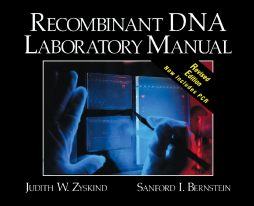
BOOK
Recombinant DNA Laboratory Manual, Revised Edition
Judith W. Zyskind | Sanford I. Bernstein
(2012)
Additional Information
Book Details
Abstract
The latest edition of this introductory benchtop manual is up-to-date, affordable, and easy-to-follow. This text is perfect for your two-quarter or one semester course in Recombinant DNA Techniques and is specifically designed to lead your student or technician, who is a newcomer to molecular biology, from the basic skills of growing and maintaining bacterial colonies through plasmid DNA isolation, cloning, DNA sequencing, and hybrid detection.
- Comb-bound, three-column, large 9-1/4" x 7-1/2" format
- Exercises contain explanatory material and margin notes that pinpoint critical steps and important concepts
- Necessary reagents and equipment are presented in a checklist at the beginning of each protocol
- Techniques for bacteria are complemented with those for Drosophila
- Each experiment has been tested in the laboratory by students for five years
- Features a complete chapter on computers in the molecular biology laboratory
- Presents helpful appendixes on safety in the laboratory, frequently used ancillary techniques, and recipes for buffers, media, and strains
"The manual is bound with a comb and is sufficiently small that it can be conveniently used at the work bench. The protocols are clearly written, with separate layout of materials and instructions, much like a cookbook recipe. Some of the protocols are written so that students can fill in appropriate information. Wide margins provide plenty of space for notes, and some of the margins already contain helpful information about calculations, special handling, and precautions." --ANALYTICAL BIOCHEMISTRY
"This book contains very interesting and practical information about the methodology of recombinant DNA which is one of the most useful techniques at present in molecular biology... This manual would be very useful for molecular biologists, physiologists, biochemists, and advanced students." --JOURNAL OF STEROID BIOCHEMISTRY
"This is the most appropriate text available for the two week intensive course for professionals that we offer. The protocols are excellent with the perfect amount of background information and experimental detail." --LINDA STRAUSBAUGH, The University of Connecticut
"It covers a wide range of topics, covers them thoroughly, and eliminates the need for lab handouts." --S. ACKERMAN, University of Massachusetts
